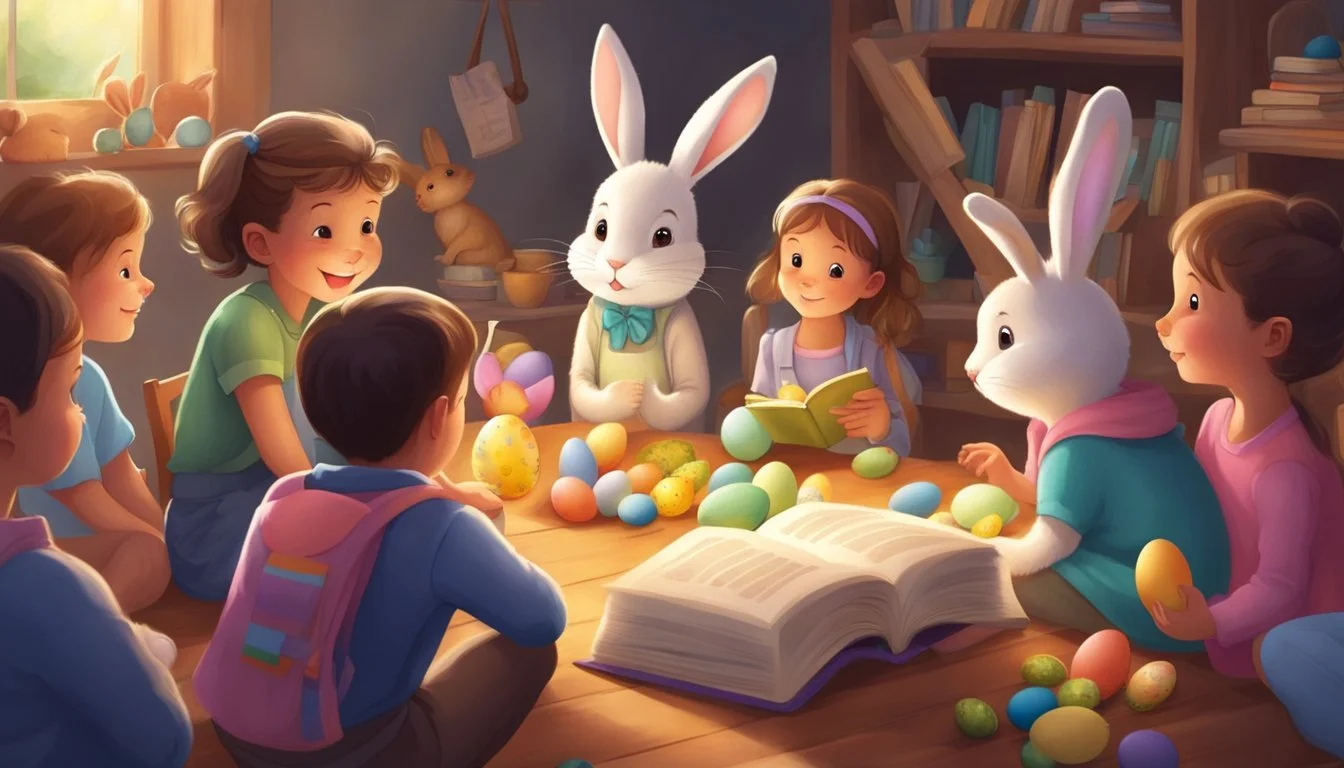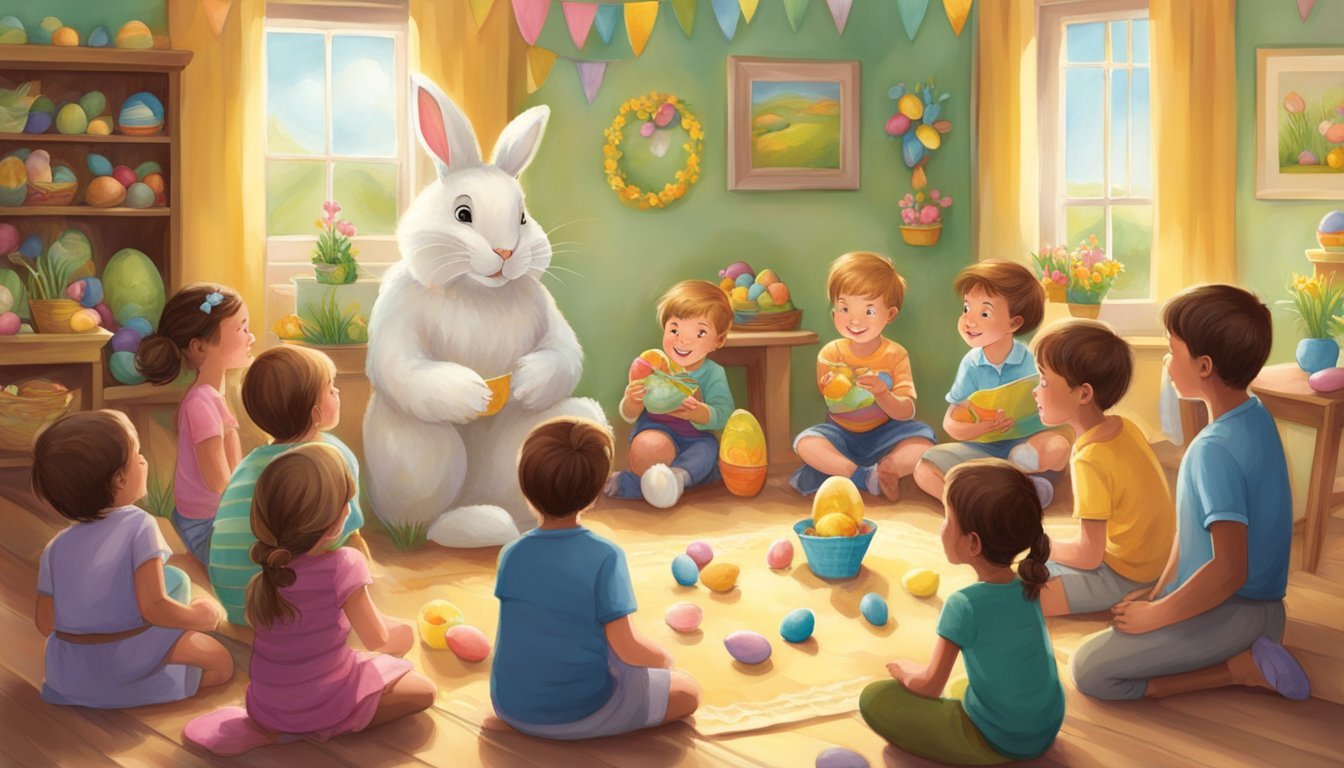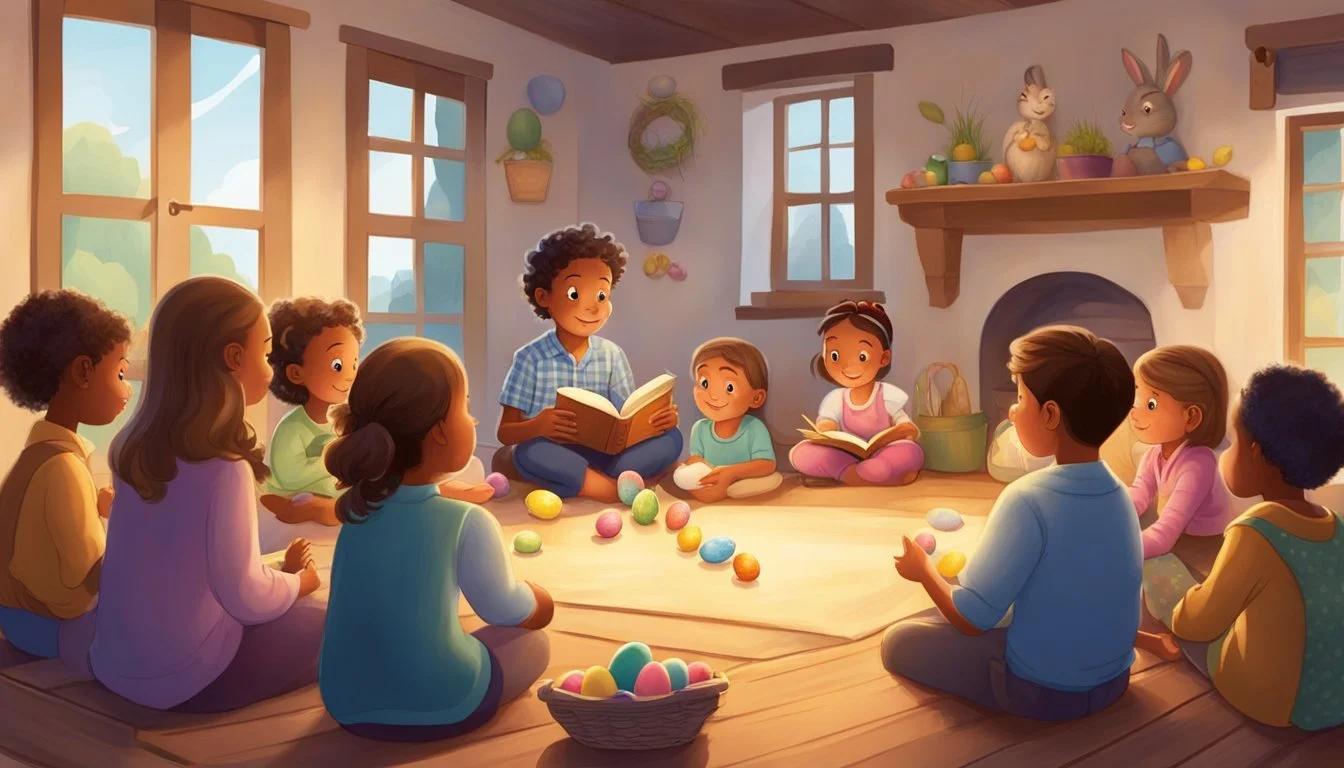Easter Story Time
Classic Tales for Kids to Delight and Teach
Easter is a time of reflection and joy, celebrated by many around the world. For children, it often combines the significance of cultural and religious traditions with the delight of Easter eggs and bunnies. Classic tales and stories designed for kids become instrumental in conveying the deeper meanings of the holiday. These stories serve to educate and entertain, weaving narratives that reflect the themes of rebirth, sacrifice, and celebration that are central to the Easter season.
Children's Easter stories often begin with the historical events commemorated during Holy Week. The narrative of Easter for kids encompasses the triumphal entry of Jesus into Jerusalem, the Last Supper, and the events leading up to the crucifixion on Good Friday and the resurrection on Easter Sunday. However, Easter tales for children are not limited to religious stories. They also include lively folktales and myths from various cultures that touch upon the spring season, renewal, and other themes that resonate with the Easter holiday.
Classic tales curated for the Easter season often bring families together, opening doors to discussions about the traditions and values that shape this time of the year. From the tale of the Rabbit with the Long Ears, a Native American folklore, to the Greek myth of Persephone and the Seasons, these stories maintain a wealth of cultural heritage that enlightens and broadens the minds of young readers. Such collections of Easter stories are timeless treasures, offering a blend of moral lessons and festive joy suitable for family reading and celebration.
The Significance of Easter
Easter is a central holiday in the Christian faith, commemorating the resurrection of Jesus Christ and representing themes of redemption and rebirth. It is recognized not only as a day of joy but also as a fulfillment of Biblical prophecy.
The Christian Faith and Easter
Resurrection of Christ: For Christians, Easter is the celebration of Jesus Christ rising from the dead three days after his crucifixion. This event is seen as the cornerstone of their faith, encapsulated in scripture and heralding Christ’s victory over sin and death.
Salvation: It's believed that through Jesus' sacrifice, humanity is offered salvation and the promise of eternal life in heaven.
Holy Season: The lead up to Easter, known as Lent, is a 40-day period of fasting, prayer, and penance, culminating in Holy Week, which includes Maundy Thursday, Good Friday (the day Jesus was crucified), and Easter Sunday.
Symbols of Easter and Their Meanings
Cross: The cross, where Jesus was crucified, is a paramount symbol of Easter, representing the sacrifice he made for the sins of the world. It's a constant reminder to believers of the price paid for their redemption.
Easter Symbols Table:
Symbol Meaning Egg Signifies new life and rebirth, reflecting Jesus' resurrection. Bunny Popular for its prolific breeding, symbolizing new life. Lamb Associated with Jesus, often called the "Lamb of God". Easter Lilies These white flowers symbolize purity and renewal.
Each symbol is steeped in tradition and embedded with significant meaning that adds depth to the holiday’s observance.
The Easter Story
The Easter Story for kids encapsulates the seminal events of the last week of Jesus Christ's life, highlighting His death, resurrection, and the profound lessons emanating from these occurrences.
The Last Week of Jesus's Life
Palm Sunday: Celebrated as the Triumphal Entry, this day marks Jesus's arrival in Jerusalem, where He was greeted by crowds laying palm branches at His feet.
Maundy Thursday: During the Last Supper, Jesus dined with His disciples, establishing the ritual of communion, and predicted Judas's betrayal and Peter's denial.
Garden of Gethsemane: Jesus prayed fervently here as He grappled with the weight of His imminent sacrifice, leading to His arrest by religious leaders with Judas's betrayal.
The Crucifixion and Resurrection
Good Friday: Jesus, after being tried by the Roman governor Pontius Pilate, was crucified, signifying a sacrificial act for redemption. His death on the cross was marked by profound suffering and sacrifice.
The Tomb: After His death, Jesus was placed in a tomb, sealed with a large stone.
Resurrection: Defying death, Jesus rose from the tomb on the third day, presenting the core truth and essence of the Easter season – a testament to love and triumph over death.
Lessons from the Easter Story
Sacrifice and Love: The Easter Story imparts lessons on the ultimate sacrifice of Jesus for humanity out of love.
Mission and Truth: It reaffirms Jesus's mission on Earth and the enduring truth that resurrection brings hope and renewal.
The narrative of Easter serves as a bedrock to the faith for many, teaching values of hope, rebirth, and the everlasting power of unconditional love.
Easter Traditions and Celebrations
Easter celebrations hold a special place in the hearts of many, with parents and children engaging in time-honored rituals. These traditions often revolve around the Easter story, symbolizing hope and new beginnings.
Easter Around the World
Global Customs:
Italy: In Italy, one might witness the "Scoppio del Carro," a fireworks display that symbolizes bringing a successful harvest.
Australia: Replacing the Easter bunny, the Easter Bilby, an endangered native animal, becomes the festive symbol.
Sweden: Children dress up as Easter witches, going door-to-door for sweets.
Religious Observance:
The Easter story is pivotal worldwide; for Christians, events like sunrise services on Easter Sunday commemorate the resurrection of Jesus Christ.
In many countries, people attend special church services, where the story of Easter is retold and celebrated with hymns.
Easter Crafts and Activities
For Young Children:
Creation of Easter Baskets: Children weave or decorate baskets to carry Easter treats.
Easter Egg Hunting: An exciting activity for children, where they search for eggs hidden by parents or teachers, often in a backyard or indoors if weather does not permit.
Creative Projects:
Easter Crafts:
Making resurrection eggs, which are decorated eggs that contain items inside to tell different parts of the Easter story.
Printable coloring pages featuring bunnies and other Easter-related scenes engage younger children.
Crafts for Learning:
Teachers often use Easter-themed printable activities to teach children about the holiday's traditions.
Parents may incorporate the making of Easter crafts into story time, helping link the creation of items like the Easter basket to the larger Easter narrative.
Incorporating Easter Stories into Learning
Easter stories for children offer more than entertainment; they are treasure troves for teaching important concepts such as joy, love, hope, and kindness. When these tales are shared appropriately, they become powerful tools for learning and language development.
Engaging Children with Easter Tales
Age-Appropriate Selection: Tailoring stories to the child's age ensures comprehension and maintains interest. For young children, stories with simple language and bright, colorful images are ideal. They are usually shorter in length to accommodate shorter attention spans.
Use of Props: Props bring stories to life, making the storytelling session interactive and engaging. Common props for Easter stories can include stuffed bunnies, plastic eggs, or illustrations. These aids help children visualize the narrative and connect with the theme of rebirth and renewal inherent in many Easter tales.
Storytelling Techniques and Teaching Tips
Language Development: During storytelling, asking questions can help children develop their language skills. For instance, "What do you think the bunny will find next?" encourages prediction and conversation.
Interactive Elements: To make the storytelling interactive, children can be asked to participate by making relevant sounds, pointing out objects in the book, or even helping turn the pages. This engagement solidifies their role as active participants in learning.
Teaching Values: Easter stories often center around themes of hope and fresh beginnings. Teachers can use these narratives to discuss how these themes appear in the children's own experiences. Sharing stories of kindness and love can also instigate discussions on how to embody these values in daily life.
Selected Easter Tales for Different Age Groups
Easter story time is a cherished tradition, offering a wonderful opportunity to introduce children to the themes and messages of the Easter season through literature. Selecting age-appropriate tales for story time is essential; doing so ensures engagement and comprehension, allowing the essence of Easter to unfold in a manner tailored to each child's stage of maturity.
Easter Stories for Toddlers and Preschoolers
For toddlers and preschoolers, simplicity and visual engagement are key. These young children thrive on stories with bold illustrations and relatable characters.
Recommended Easter Stories:
"Peter Rabbit" by Beatrix Potter: This classic tale, though not directly related to Easter, has become synonymous with the holiday, providing a fun adventure that is age-appropriate and endearing.
"The Easter Egg" by Jan Brett: With beautifully detailed illustrations, this story captivates young children and conveys themes of compassion and perseverance.
Books Characteristics:
Illustrations: Captivating, bold, and colorful.
Language: Simple, rhythmic, and easy to follow.
Timeless Easter Stories for School-Aged Children
As children grow, they are able to grasp more complex narratives and the deeper meanings behind the Easter celebration. For school-aged children, stories can explore themes of hope, sacrifice, and renewal with greater depth.
Cherished Anthologies:
"Easter Stories: Classic Tales for the Holy Season": This collection includes a variety of tales by well-known authors such as C.S. Lewis and Leo Tolstoy. It offers a spiritual and literary journey that is suited to the American cultural context and the growing maturity level of school-aged children.
Stories Attributes:
Content: Rich in moral and thematic depth.
Maturity Level: Suited for the developing comprehension and empathy of children between 5 and 12 years of age.
Annotated Bibliography of Classic Easter Tales
Classic tales that embody the spirit of Easter often blend themes of rebirth, renewal, and redemption. This annotated bibliography highlights key works that resonate with the Easter narrative, presenting a concise guide for parents and educators seeking meaningful stories for Easter Story Time with children.
Easter Stories: Classic Tales for the Holy Season
Edited by Miriam LeBlanc, Illustrations by Lisa Toth
A collection of tales that, while not always directly referencing Easter traditions, convey the essence of Easter through stories of transformation and hope. Features an array of writers including Leo Tolstoy and Elizabeth Goudge.
The Tale of Three Trees: A Traditional Folktale
Retold by Angela Elwell Hunt, Illustrations by Tim Jonke
This folktale tells the story of three trees, each with grand aspirations, that eventually play a role in the life of Jesus Christ, intertwining their fate with the Easter message.
The Lion, the Witch and the Wardrobe
By C.S. Lewis
While not explicitly about Easter, this classic children's novel by C.S. Lewis is teeming with allegorical references to the resurrection theme, making it a relevant story to share during the Easter season.
Leo Tolstoy's Short Stories
By Leo Tolstoy
Readers can find profound spiritual themes relevant to Easter in Tolstoy's short stories such as "Where Love Is, God Is" and "The Three Hermits," which explore themes of faith, love, and rebirth.
The Easter Story
By Brian Wildsmith
An illustrated account of the Biblical story of Easter, capturing the sequence of events leading to the resurrection of Jesus Christ. Wildsmith's book is aimed directly at children, using vivid imagery and narrative to convey the core message of Easter.
These works are essential resources that shed light on the principles and stories that reflect upon the season's themes, making them suitable for children's Easter Story Time.






